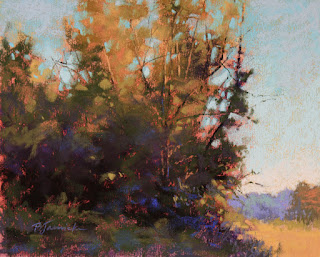 |
| Morning Glow, pastel, 8x10 |
In my Monday class at Spruill Center for the Arts this morning, we created an underpainting that would contrast nicely with the final colors used in the painting, as well help add to the warm glow of the sunlit areas.
I typically use a small variety of Nupastels (usually 4 or 5) for this type of underpainting. Nupastels work well for two reasons:
1) They're hard pastels and don't "gum up" when you wet down the underpainting, since less pigment is actually applied with a harder pastel than with the buttery soft brands. Very little pigment is needed for a liquid underpainting.
2) A small standard set of Nupastels comes in fairly bright colors...not usually good for straight painting, since your palette would lack the necessary neutrals and less intense hues, but ideal for setting up a colorful underpainting.
Although I often use a monochromatic underpainting to focus on establishing a strong value structure for the start of a painting, when I want color to play a key role in the painting, or to add a "glow" as I wanted here, I'll instead use strong color in this initial stage. (And yes, sometimes I do use a combination of both.)
Below are a few demo shots of the progression...







.JPG)
.JPG)
.JPG)
.JPG)
